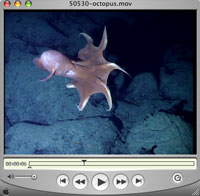|
|

 Today's Weather Overcast, Mostly Cloudy Lat: 00° 48.48'N Long: 086° 13.65'W Wind: S Sea State: 3 Swell Height: 4-6ft Baro Press: 1007.9mb Air Temp: 24.7°C 76.7°F Sea Temp: 26.6°C 79.9°F Vis: 7-9nm  Quicktime Movie » Windows Media Player » Two days ago, divers in Alvin spotted this octopus from the viewport. Notice its eye and the two fins on the sides of its mantle. Divers said that when the octopus spread its tentacles, it appeared to be the size of an umbrella.  Recovering Instruments at Rosebud When scientists made their first Alvin dives to the Rosebud hydrothermal vent field at the beginning of this expedition, they placed several recording instruments on the seafloor. During their week on the seafloor, the instruments had different jobs—taking photos, recording temperature data, trapping larvae—all designed to identify changes and developments in the vent community over time. Today we began recovering these instruments. Some came up on Alvin’s basket this evening. But another, the RatCam—named by Alvin pilot Pat Hickey who thought it looked like a rodent—bobbed to the sea surface around 1:30 pm. Two hours earlier, divers in Alvin had pulled a pin that released it from its anchor. After crewmembers spotted its yellow floats at the surface about 40 yards (36 meters) from Atlantis, mate Craig Dickson maneuvered the ship to get close, then secured the RatCam with hooks and lines. Crewmembers used the crane to pull it on board. Biologist Tim Shank was pleased with the information it recorded—more than 1,600 pictures that reveal changes in the community of mussels over the past week. That wasn’t the only experiment collected today that focused on community change over time. A second focused on how tiny offspring of tubeworms, mussels and other vent animals settle and establish new communities. It’s similar to why people decide to live in certain neighborhoods—primarily, because the conditions there fulfill their particular needs. To gather his samples, Tim used Alvin to place pre-cut, 4-inch (10-centimeter) squares of basalt on the seafloor and left them there for the week. The squares were like Petri dishes, growing microbes and larvae in its natural surroundings and providing an accurate picture of their settlement patterns. Nearby, sensors monitored the temperature and chemistry of the water for a clearer picture on how the vents influence settlement and colonization of larvae. Tonight biologist Stace Beaulieu will prepare for analysis on shore. Using forceps, she will pluck tiny larva off the basalt squares and place them in tubes to be frozen for later genetic studies. Though we noticed yesterday the slight potential of an approaching storm from the north, it never materialized. However Alvin’s launch was a bit bumpy as waves up to six feet (two meters) caused the sub to roll on the surface before submerging. Geochemist Susan Humphris, who was watching the launch from Atlantis, said that after more than 30 Alvin dives she knows the feeling of rough sea surface conditions. “It’s like being in a washing machine,” she said. “Water sloshes over the viewports as Alvin bounces around in the waves.”
Read the new interview
Mail Buoy Do you have questions about oceanographic research, hydrothermal vents, or about what it is like to work on board a ship? E-mail your questions to the scientists working on board RV Atlantis at divediscover@atlantis.whoi.edu. Please tell us your town and state, and keep your messages short with no attachments. Read today's mail »
|
|||||||||||||||||||||||||||||||||||||||||||||||||||||||||||||||||||||||||||||||||||||||||||||
Mailing List | Feedback | Glossary | For Teachers | About Us | Contact
© 2010 Dive and Discover™. Dive and Discover™ is a registered trademark of
Woods
Hole Oceanographic Institution

 Geochemist William E. Seyfried Jr: Who inspired Bill Seyfried to pursue a career in geochemistry, great scientists like Marie Curie and Louis Pasteur? No, it was his family and teachers. Learn how Bill designs tools at the University of Minnesota to research chemistry in the oceans, then goes to sea to test them for use at hydrothermal vents.
Geochemist William E. Seyfried Jr: Who inspired Bill Seyfried to pursue a career in geochemistry, great scientists like Marie Curie and Louis Pasteur? No, it was his family and teachers. Learn how Bill designs tools at the University of Minnesota to research chemistry in the oceans, then goes to sea to test them for use at hydrothermal vents.